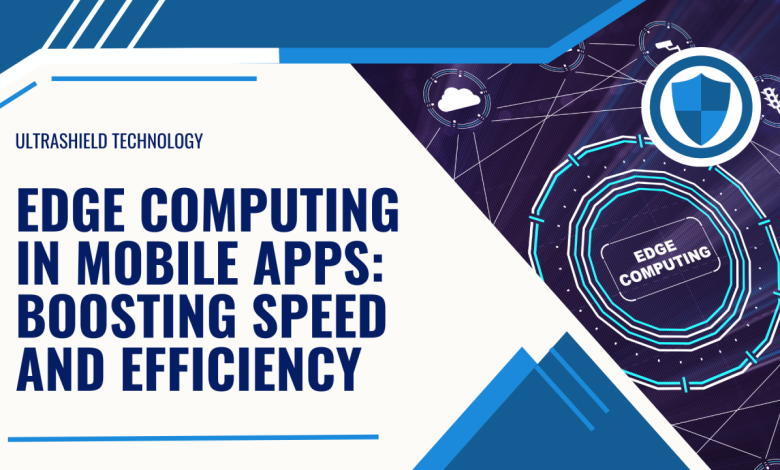Edge Computing for Mobile Apps: Speed, Privacy, and On-Device Intelligence

In today’s digital world, mobile apps are expected to deliver instant responses, personalized experiences, and robust privacy. Traditional cloud-based architectures, while powerful, often introduce latency, dependency on stable internet connections, and potential privacy concerns. This is where edge computing comes into play.
Edge computing moves computation and data processing closer to the user’s device, enabling faster responses, reduced bandwidth usage, and enhanced privacy. For mobile app developers, understanding and leveraging edge computing is no longer optional—it is becoming a critical component of high-performance, intelligent, and privacy-conscious apps.
This article explores the principles of edge computing, its applications in mobile app development, technical considerations, and best practices for implementing on-device intelligence.
What is Edge Computing?
Edge computing is a decentralized computing paradigm where data processing occurs near the source of data, rather than relying entirely on centralized cloud servers. In the context of mobile apps:
- Edge devices can be smartphones, tablets, or IoT devices.
- Computation is performed locally or on nearby servers, reducing round-trip latency.
- Only critical or aggregated data may be sent to the cloud, preserving bandwidth and privacy.
Key Benefits for Mobile Apps:
- Low Latency: Faster responses for real-time applications.
- Bandwidth Efficiency: Reduces reliance on continuous network connectivity.
- Enhanced Privacy: Sensitive data remains on the device, mitigating security risks.
- Offline Functionality: Apps can function intelligently even without internet access.
Applications of Edge Computing in Mobile Apps
1. Real-Time AI and Machine Learning
Mobile apps increasingly rely on AI models for image recognition, natural language processing, and recommendation engines. Running these models on the edge enables:
- Instantaneous feedback without waiting for cloud inference.
- Energy-efficient processing using optimized on-device models.
Example:
A mobile photo editing app can apply real-time style transfer filters to images or videos without sending data to the cloud. Similarly, voice assistants can process commands locally for faster interaction and improved privacy.
2. Personalized User Experiences
Edge computing enables apps to analyze user behavior and preferences locally. This allows:
- Personalized recommendations without sending sensitive data to external servers.
- Dynamic UI adjustments based on real-time interactions.
Example:
A fitness app can track user performance, adjust workout difficulty, and generate motivational prompts—all on-device, ensuring user data stays private.
3. Gaming and AR/VR Applications
Games and augmented reality (AR) apps demand ultra-low latency. Edge computing provides:
- Real-time physics calculations and AI-driven NPC behavior.
- Local rendering of AR content, minimizing lag.
Example:
AR navigation apps can overlay directions on live camera feeds in real-time, even in areas with poor connectivity, by processing location and sensor data locally.
4. IoT and Wearable Integration
Mobile apps connected to IoT devices or wearables benefit from edge processing by:
- Aggregating and analyzing sensor data locally.
- Reducing cloud communication overhead.
- Providing instant alerts or actions based on sensor events.
Example:
A smartwatch health app can detect abnormal heart rates in real-time and alert the user immediately without waiting for cloud analysis.
Technical Considerations for Edge Computing
Integrating edge computing in mobile apps requires careful planning:
1. Model Optimization
AI models must be lightweight to run efficiently on mobile devices. Techniques include:
- Quantization: Reducing precision of model weights to save memory.
- Pruning: Removing redundant neurons or connections.
- Knowledge Distillation: Transferring knowledge from large models to smaller, faster models.
2. Hardware Acceleration
Modern smartphones include AI accelerators, GPUs, and NPUs. Leveraging these hardware components improves performance and energy efficiency.
Example:
TensorFlow Lite, Core ML, and ONNX Runtime provide frameworks to deploy models on mobile devices using hardware acceleration.
3. Data Privacy and Security
Edge computing enhances privacy, but developers must still:
- Encrypt sensitive data stored on the device.
- Ensure secure communication for any cloud interaction.
- Implement sandboxing and permissions to prevent unauthorized access.
4. Hybrid Edge-Cloud Architectures
Not all tasks can be performed efficiently on-device. A hybrid approach balances performance and capability:
- On-device: Real-time inference, immediate personalization, local caching.
- Cloud: Heavy model training, global analytics, large-scale data aggregation.
This approach optimizes latency, reduces bandwidth, and ensures the app remains functional offline.
Architectural Patterns for Edge Mobile Apps
1. Layered Edge Architecture
- Presentation Layer: Handles UI and user interaction.
- Edge Logic Layer: Processes data locally, including AI inference.
- Cloud Layer: Handles synchronization, analytics, and heavy computations.
2. Event-Driven Processing
Edge devices can use event-driven architectures to trigger computations only when necessary, reducing battery consumption and improving responsiveness.
3. Modular AI Services
Splitting AI logic into modular services allows developers to update or replace individual models without affecting the entire app.
Case Studies
1. Google Pixel Camera
- Implementation: Uses on-device AI for Night Sight, portrait mode, and HDR+ processing.
- Impact: Faster photo processing, reduced cloud dependency, and improved privacy.
2. Apple Siri
- Implementation: Recent iOS versions run speech recognition locally on the device.
- Impact: Lower latency, offline capabilities, and improved privacy for users.
3. Mobile AR Games
- Example: Pokémon GO uses edge computing to process camera feeds and location data locally while syncing with cloud servers for game state and multiplayer features.
Future Trends
- Federated Learning: Edge devices collaboratively train models while keeping user data private.
- TinyML: Ultra-compact AI models that run efficiently on minimal hardware.
- AI Hardware Evolution: Dedicated NPUs and GPUs optimized for mobile edge computing.
- Edge-to-Cloud Orchestration: Seamless interaction between local intelligence and cloud analytics.
Conclusion
Edge computing is redefining mobile app development, offering speed, privacy, and on-device intelligence. By processing data closer to users, apps can deliver real-time personalized experiences, function offline, and minimize dependency on cloud infrastructure.
For mobile developers, mastering edge computing involves:
- Optimizing AI models for mobile hardware.
- Balancing on-device and cloud processing.
- Ensuring robust security and privacy.
- Leveraging modular, event-driven architectures.
As AI and edge hardware continue to evolve, apps that leverage edge computing will set new standards for performance, user experience, and privacy.

